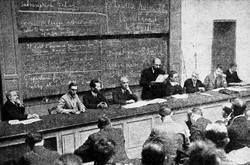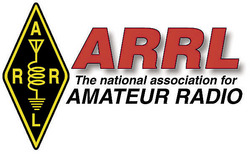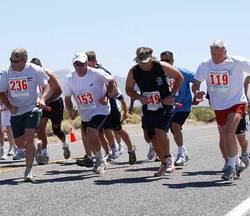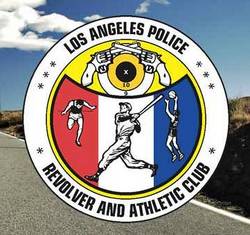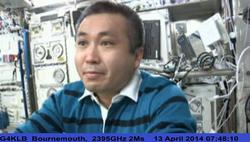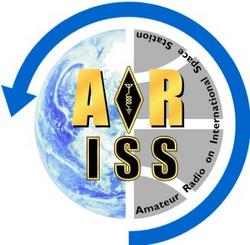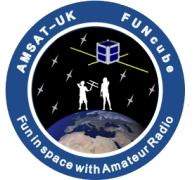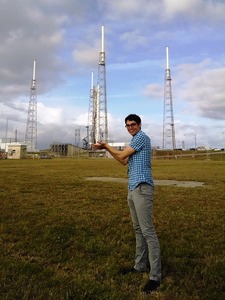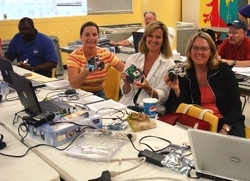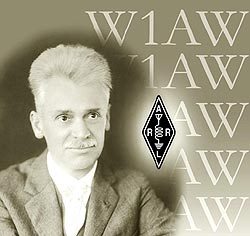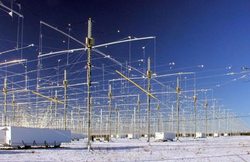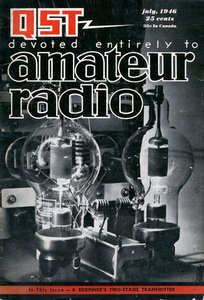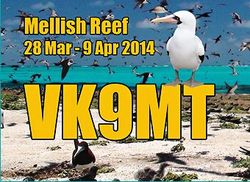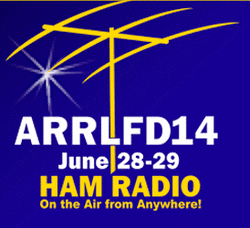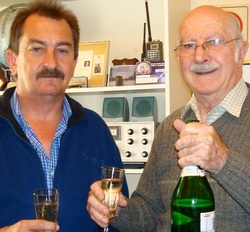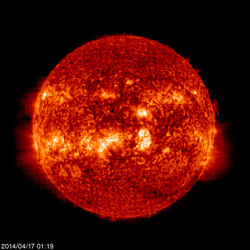 April 17, 2014 John E. Ross, KD8IDJ, Editor
| |||||||||||||||||
ARRL Headquarters Closed on April 18: ARRL Headquarters will be closed on Good Friday, April 18. There will be no W1AW bulletin or code practice transmissions and no ARRL Audio News on April 18. ARRL Headquarters will reopen Monday, April 21, at 8 AM Eastern Daylight Time. We wish everyone a safe and enjoyable holiday! International: World Amateur Radio Day is Friday, April 18 "Amateur Radio: Your Gateway to Wireless Communication" is the theme for World Amateur Radio Day 2014, Friday, April 18. Radio amateurs celebrate World Amateur Radio Day each year on April 18 to recognize the anniversary of the founding of the International Amateur Radio Union (IARU) in Paris in 1925. ARRL Co-Founder Hiram Percy Maxim, 1AW, was its first president. The primary purpose of World Amateur Radio Day is to highlight Amateur Radio and its benefits to countries and communities. This year the IARU and its more than 150 member-societies are marking the organization's 89th anniversary.
"Amateur radio has truly entered the 21st century. In less than 100 years Amateur Radio communication has evolved from crude spark-gap technology to digital signal processing and software-defined radios," the IARU has pointed out. "The amateur's HF choice between voice and CW has been expanded to a broad range of communication choices from television to spread spectrum." Amateur Radio experimenters were the first to discover that the short wave spectrum -- far from being a wasteland -- could support worldwide propagation. As the rush to shorter wavelengths ensued, however, Amateur Radio was "in grave danger of being pushed aside," the IARU's history has noted. So, Amateur Radio pioneers met in Paris in 1925 and created the IARU to support Amateur Radio worldwide. World Amateur Radio Day activities and special events are an opportunity to spread the word about what radio amateurs are doing in the 21st century. Several IARU member-societies and associated clubs are expected to sponsor special event stations to mark the occasion this weekend. Among them will be the Puerto Rico Field Day Group, which plans to activate KP4FD on April 18. Others to listen for include HZ14WARD in Saudi Arabia, SK89WARD in Sweden, and A91WARD in Bahrain. Regulatory: ARRL Asks FCC to Dismiss "Fatally Flawed" Petition for Rule Making Affecting 10 GHz The ARRL has told the FCC that a Petition for Rule Making (RM-11715) from Mimosa Networks to permit unlicensed Part 15 wireless broadband services in the 10.0-10.5 GHz band is "fatally flawed" and should be dismissed. Mimosa filed the Petition in May 2013, and the FCC invited public comments last month. The Petition includes a band plan for 10.0 to 10.5 GHz that would cede Amateur Radio and Amateur-Satellite users access to just two small segments of the present allocation. The League told the FCC that, among other things, the Mimosa Petition is inconsistent with a US footnote in the domestic Table of Allocations, and that fact alone is sufficient reason for the Commission to quash Mimosa's request. "Footnote US128 very clearly and without equivocation prohibits all non-Federal services in the band 10-10.5 GHz except for the Amateur Service, the Amateur-Satellite Service, and the non-Federal radiolocation service," the ARRL said in its comments. The FCC "is not at liberty to ignore" the US footnote, the League said, and is obliged on that basis alone to dismiss the Petition, "because it hasn't the authority to grant it."
Approval of the Mimosa Petition hinges on FCC adoption of rule changes that would put the 10 GHz band under Subpart Z of the Commission's Part 90 rules. Subpart Z currently sets out regulations governing wireless licensing, technical standards, and operational standards in the 3650 to 3700 MHz band. Mimosa told the FCC that the "application of the coordination procedures and requirements provided in Subpart Z will ensure that Amateur Radio operations in the band will not be disrupted." Its proposed band plan, the company said, would protect frequencies in the band "that are most often used by Amateur Radio operators," but the plan itself would carry no weight, since Mimosa failed to mention it among the rules changes it proposed. The plan would specify 10.350 to 10.370 GHz as an "Amateur Calling Band," and 10.450 to 10.500 GHz for Amateur-Satellite operations in the midst of 21 wireless broadband channels and a small guard band. "[T]here is no 'sharing' between allocated radio services and Part 15 devices," the ARRL said. "Part 15 unlicensed devices have no allocation status...and are prohibited from causing interference to any authorized radio service. That is not the regulatory paradigm proposed by Mimosa for the 10.0-10.5 GHz band." The League pointed out that Amateur Radio operations exist throughout the 10.0 to 10.5 GHz band now, and that Mimosa's protocols for avoiding interference would not protect repeater input frequencies or interference to receivers used in "weak-signal" amateur operation. "Increases in the noise floor in this band that would result from wireless broadband operations as proposed would simply foreclose most or all amateur use of the band on an ongoing basis," the ARRL asserted. Even if the FCC could proceed with the proposed allocation, the League said, it would be "premature" to do so, because the US is now developing positions in advance of World Radiocommunication Conference 2015 (WRC-15). The League said WRC-15 agenda item 1.12 could have "a profound effect" on the 10.0-10.5 GHz band in ITU Region 2. "Action domestically on the Mimosa Petition now would foreclose certain options that the United States may wish to advocate at WRC-15, and the WRC-15 final acts may have an effect on this band as well," the League explained. "[I]t is quite obvious that Mimosa has propounded a seriously flawed proposal which fails to justify the allocation," the League concluded. "The Petition should be dismissed without action by the Commission without delay." Read more. Public Service: Amateur Radio Volunteers Provide Critical Support for 30th Challenge Cup Relay Amateur Radio volunteers were key to maintaining safety and security for the thousands of law enforcement personnel who took part in the
Baker to Vegas Challenge Cup Relay (B2V) race on March 22. This year marked the 30th anniversary of the event, sometimes called "The world's longest police foot pursuit." The relay event covers some 120 miles of remote territory, from the Mojave Desert near Baker, California -- the gateway to Death Valley -- to Las Vegas, Nevada. "This year we started 261 teams over a span of 9 hours," B2V Communications Director Joy Matlack, KD6FJV, told ARRL. "All of the teams that started the race finished, which sometimes is not the case. We had a minimal level of injuries this year -- only five airlifts -- so that made this year's race all the better." The grueling route tests human endurance in an environment where rattlesnakes thrive and the temperature has topped 130° F. The race course winds through the Mojave Desert, crosses the Spring Mountains at Mountain Springs Pass (elevation 5530 feet) and descends into Las Vegas. The terrain and race logistics also challenge the communication system, which needs to cover some 8100 square miles. Given a lack of conventional telecommunication services, the vast impromptu telecommunication infrastructure incorporates ham radio as well as business band, aeronautical, and public safety systems. "We have multiple layers of communications, and most are tied into an integrated ham radio network," Matlack explained. Many teams bring along their own ham radio teams to provide logistical support for their runners, she added. Matlack said the B2V starts out with some 325 or so volunteers, who support communication with and for the race director and other officials as well as provide information to and from each of the 22 baton exchange points. She said individual teams that use ham radio bring out another 325 hams along the course. The primary mission of the Amateur Radio volunteers is the protection and safety of runners and their support-vehicle staff members. To keep a close eye on the early part of the course, where runners face the most severe conditions, Matlack dispatches a smaller Safety Patrol consisting of a coordinator and trained radio amateurs. The Safety Patrol checks the condition of each runner, while keeping in contact with race officials and medical personnel as necessary.
The race takes place in 20 stages, where the teams change runners. Amateur Radio operators serve as the race staff at these stages, provide scoring and timing functions, handle the PA system, call in the medics if necessary, and handle all routine and emergency event radio traffic. The B2V is sponsored by the Los Angeles Police Revolver and Athletic Club, which has limited the number of entries to 270 teams. With family, friends and onlookers the crowd can grow to more than 10,000 people. Read more. -- Thanks to Joy Matlack, KD6FJV; John Bigley, N7UR, Nevada Amateur Radio Newswire Ham Radio in Space: Astronaut Emcees Live Amateur Radio Digital TV Test from the ISS Japanese Astronaut Koichi Wakata, KC5ZTA, served as the host for a successful final commissioning test pass April 13 for the Amateur Radio on the International Space Station (ARISS) "Ham Video" transmitter and camera. Operating as OR4ISS from the ISS Columbus module, Wakata transmitted digital video and audio, as ground stations in France and Italy tracked the station. G4KLB, F6DZP, and IK1SLD were among those receiving clear video and audio during the approximately 6 minute pass. They streamed the signal over the Internet via the British Amateur Television Club (BATC) server. The test used so-called "configuration 4" -- 2395 MHz with ARISS antenna 43.
"The final Ham Video commissioning pass was performed flawlessly Sunday, April 13, at 1823 UTC," ARISS Europe Chairman Gaston Bertels, ON4WF, proclaimed. "Congratulations to the Ham Video team for this outstanding performance. Next step should be a video-enhanced ARISS school contact." During the pass, Wakata congratulated ARISS for its achievement and answered a series of questions "in the manner of a school contact," Bertels explained. He also conducted a microgravity experiment. In early March, as one of his final actions during his duty tour aboard the International Space Station, NASA Astronaut Mike Hopkins, KF5LJG, installed and commissioned the ARISS Ham Video transmitter and camera. He also was the first member of an ISS crew to transmit his image to Earth using the Amateur Radio digital television (DATV) setup.
The ARISS project, led by ARISS-EU, AMSAT-Italy, and the European Space Agency (ESA), eventually will enhance ARISS school contacts by providing a video and audio downlink plus an audio-only uplink. Commissioning of the overall "Ham TV" Amateur Radio DATV system marked the culmination of more than a decade of planning and preparation within ARISS. Although there are no immediate plans to employ Ham TV for educational contacts with schools in North America, ARISS International President Frank Bauer, KA3HDO, said several US radio amateurs are testing this capability. "If this shows educational value," he said, "it will be employed in the US." The Ham Video transmitter has downlink frequencies of 2.422, 2.437, 2.369 and 2.395 GHz in a DVB-S type format (symbol rates of 1.3 Ms/s and 2.0 Ms/s). The two patch antennas, ARISS 41 and ARISS 43, are located on the nadir of the Columbus module. The Ham Video transmitter puts out approximately 10 W EIRP. The camera is a Canon XF-305. -- Thanks to ARISS International President Frank Bauer, KA3HDO, and ARISS-EU Chairman Gaston Bertels, ON4WF Ham Radio in Space: FUNcube/AO-73 Transponder Will Be Active Each Weekend The FUNcube/AO-73 Amateur Radio transponder will be active full time (with low-power beacon) on weekends.
FUNcube's controllers will switch to full-time transponder mode during the first suitable pass over the UK on Friday, typically between 1930 and 22:30 UTC. (If this is not possible, the switch will be made on the first suitable pass on Saturday, typically between 0930 and 1200 UTC. Controllers will switch off full-time transponder mode during a suitable pass on Sunday evening, typically between 1930 and 2230 UTC. (If this is not possible, the switch will be made during the first suitable pass on Monday, typically between 0930 and 1200 UTC. This schedule is totally reliant on the availability of command stations. AO-73's telemetry downlink frequency is 145.935 MHz BPSK. The SSB/CW inverting transponder uplink is 435.150-435.130 MHz LSB, and the downlink is 145.950-145.970 MHz USB. Use a maximum uplink power of 5 W into a 7 dBi gain antenna. More information is available on the FUNcube website. Comments are user reports are welcome. -- Thanks to Jim Heck, G3WGM, via AMSAT News Service Ham Radio in Space: KickSat Project Announces Telemetry Download Competition Zac Manchester, KD2BHC, of the KickSat project is offering prizes to the first stations to copy telemetry from KickSat and the "Sprite" satellites it will deploy. "I'll be offering prizes to the first several people who receive telemetry packets from KickSat as well as the first few who receive signals from the Sprites," the Cornell University aerospace engineering graduate student has announced. "The prizes will include souvenir Sprites, and CRS-3 and ELaNa-V mission patches."
The KickSat will go into space with the third SpaceX ISS resupply mission, which was delayed at least until April 18. If all goes according to plan, the 3U KickSat CubeSat subsequently will release more than 100 Sprite satellites -- each about the size of a small cracker -- into orbit. They will become the smallest Earth-orbiting satellites ever. For KickSat telemetry (437.505 MHz and 2401-2436.2 MHz), Manchester wants the raw hex or ASCII packet data, "and I have to be able to successfully decode it." For the Sprites, he wants a raw baseband recording, "and I have to be able to decode at least one Sprite signal from it." All of the Sprites are on the same frequency -- 437.240 MHz. Manchester said he is the final judge on winners, and he'll continue to offer prizes, "until I run out of cool swag." To get in on the fun, Manchester said, visit the KickSat Wiki and sign up for the KickSat mailing list. AMSAT-UK also has posted a report. Your League: Deadline is May 1 to Apply for ARRL Teachers Institute The ARRL Education & Technology Program (ETP) is still accepting applications for all sessions of the ARRL Teachers Institute this summer. The application deadline is May 1. Admission decisions will be made by May 9.
Learn how to integrate science and mathematics with engineering and technology by exploring wireless technology! Now in its 11th year, the ARRL Teachers Institute is a 4-day, expenses paid, intensive professional development opportunity for educators who want to receive training and resources to explore wireless technology in the classroom. ARRL will offer two sessions of the "Introductory Teachers Institute on Wireless Technology" (TI-1) this summer. Topics include basic electronics, radio science, microcontroller programming and basic robotics. ARRL also will offer an advanced Teachers Institute (TI-2), "Remote Sensing and Data Gathering." For more details see the announcement in the March issue of QST or visit the Teachers Institute on Wireless Technology website. Download applications for both Teachers Institutes from the ARRL website. Scroll down to the "2014 TI Applications" tab. Centennial: W1AW Centennial Operations are in Mississippi and North Dakota until April 23 (UTC) The ARRL Centennial W1AW WAS operations taking place throughout 2014 from each of the 50 states now are in Mississippi (W1AW/5) and North Dakota (W1AW/0). They will relocate at 0000 UTC on Wednesday, April 23 (the evening of April 22 in US time zones), to New Jersey (W1AW/2) and New Hampshire (W1AW/1). During 2014 W1AW will be on the air from every state (at least twice) and most US territories, and it will be easy to work all states solely by contacting W1AW portable operations. In conjunction with the 100th anniversary of the ARRL, the ARRL Centennial QSO Party kicked off January 1 for a year-long operating event in which participants can accumulate points and win awards. The event is open to all, although only ARRL members and appointees, elected officials, HQ staff and W1AW are worth ARRL Centennial QSO Party points. Working W1AW/x from each state is worth 5 points per contact.
To earn the "Worked all States with W1AW Award," work W1AW operating portable from all 50 states. (Working W1AW or W100AW in Connecticut does not count for Connecticut, however. For award credit, participants must work W1AW/1 in Connecticut.) A W1AW WAS certificate and plaque will be available (pricing not yet available). Some schedule changes have been made, and the schedule has been updated to reflect these. Maine and New Mexico have swapped weeks. New Mexico's second week will start September 24, and Maine's second week will begin December 3. The District of Columbia's week has been moved to the week of October 1. North Dakota's second week has been shifted to the week of August 20. Puerto Rico will now have a second week of operation starting November 26. The ARRL has posted an ARRL Centennial QSO Party leader board that participants can use to determine how many points they have accumulated in the Centennial QSO Party and in the W1AW WAS operations. Log in using your Logbook of The World (LoTW) user name and password, and your position will appear at the top of the leader boards. Results are updated daily, based on contacts entered into LoTW. W1AW/x Portables, W100AW, and W1HQ Can QSL via Bureau You may request that QSL cards be delivered via the ARRL QSL Bureau system for contacts with the W1AW/x portable operations, W100AW, and W1HQ, now underway during the ARRL Centennial. You must first have an account with the QSL Bureau that handles your cards and have sufficient postage or envelopes on file with that bureau. Any cards that cannot be delivered will not be held or stored. Please do not send any cards for W1AW/x portable operations, W100AW, or W1HQ to ARRL via the bureau. While we appreciate the thought, we do not have room to store or file them and would rather you have fun working all the Centennial stations! This is a one-time only use of the QSL Bureau for this purpose. QSLs to stations outside the US via the QSL Bureau will be handled normally. Click here, enter your call sign, and click SUBMIT to request delivery of W1AW/x portable operations, W100AW, or W1HQ QSL cards via the Bureau. -- Thanks to Membership and Volunteer Programs Manager Dave Patton, NN1N Technology: HAARP Facility in Danger of Being Dismantled According to an April 9 Alaska Dispatch report, the High Frequency Active Auroral Research Program (HAARP) facility near Gakona, Alaska, could be decommissioned and dismantled altogether this year, unless the US Air Force can find a new prime contractor to take over the sprawling, 35-acre facility. The report said the Geophysical Institute at the University of Alaska-Fairbanks is hoping to pull together a plan to run the facility, which has long been a subject of fascination for hams and the target of conspiracy theorists. The facility shut down last year and, with the exception of some contract-funded research, it has essentially remained in standby.
Money is one major issue. The US Air Force Research Laboratory wants to see HAARP survive, "but only if someone else pays the bills, estimated at about $5 million a year," the article said. The University of Alaska Geophysical Institute is said to be trying to come up with a plan to keep HAARP up and running to continue ionospheric research. A White House Office of Science and Technology Policy meeting in February of federal agencies interested in ionospheric research came up with no viable candidates to run HAARP, however. The news account cited an Air Force spokesman as saying that final research experiments funded by the Defense Advanced Research Projects Agency (DARPA) are set to wrap up next month. HAARP had indicated 3 years ago that it would be shutting down, and it did not submit a budget request for FY 15, but that attracted scant attention at the time. Jointly funded by the US Air Force Research Laboratory and the US Naval Research Laboratory, the HAARP ionospheric research facility. Its best-known for its 3.6 MW HF (approximately 3 to 10 MHz) ionospheric research instrument (IRI) -- a transmitter feeding an extensive system of 180 gain antennas and used to "excite" sections of the ionosphere. Other onsite equipment is used to evaluate the effects. The ultra-high power facility long has intrigued hams, even outside of Alaska. In 1997, HAARP transmitted test signals on HF (3.4 MHz and 6.99 MHz) and solicited reports from hams and short-wave listeners in the "Lower 48" to determine how well the HAARP transmissions could be heard to the south. In 2007 HAARP succeeded in bouncing a 40 meter signal off the moon. Early last year, HAARP scientists successfully produced a sustained high-density plasma cloud in Earth's upper atmosphere. While the Air Force has possession for now, the unique facility will be dismantled if no other agency steps forward to take it over. Feature: A Century of Amateur Radio and the ARRL By 1945, when it became certain that the Allies would win the war, attention turned toward post-war hamming. Articles in QST described modern VFO and transmitter construction, small portable stations, antenna advances, and VHF/UHF equipment and techniques. Everyone was ready to return to "normal," and the League was pushing for that return! In May 1945, the FCC announced its plan for the Amateur Radio bands when the war was over. Among other things the 2½ and 1¼ meter bands would be shifted to the frequencies they occupy today. In June, the FCC announced that it would delete the 5 meter band and replace it with 6 meters.
And then, the war was over! The documents were signed on August 14, 1945, to formally end hostilities. On August 15, ARRL asked the FCC to re-open the ham bands. The very next day, the FCC announced that the 112 MHz (2½ meter) band would be immediately opened for ham use. Slashing through miles of red tape, the band was opened on August 21. We were back on the air, even though it was on only one VHF band that would shortly become another! Other bands were opened to ham operation as quickly as possible, but military communications first had to be moved away from the amateur bands. Making all those military frequency changes was not an easy task, but it was done as quickly as possible. After military circuits had been moved from a given ham band, the FCC would release it for ham use. The 160 meter band remained closed to hams. During the war, a then-secret navigation system called LORAN (for "Long-Range Aid to Navigation") had been developed and placed in the 1.8 to 2.0 MHz band. After the war it continued to be widely used for maritime navigation. Hams eventually were allowed back on 160 -- at first with reduced power limits but ultimately, after LORAN went away, with normal power limits. In another change that came with post-war Amateur Radio, the FCC rezoned the 48 states into 10 call areas, rather than the previous 9. New W0-prefix call signs started showing up on the air. Those were new licensees. Hams who had been living in the new 10th call area before the war could continue to use their W9-prefix call signs until renewal time, at which time their call signs were switched to the W0-prefix. By early 1946, 10 meters had been reopened for amateur use, and the ARRL threw a "Band-Warming Party" in February and March 1946. The Band-Warming Party was a worldwide QSO party, with both CW and phone operation. It was a nice way to celebrate being back on the air! -- Al Brogdon, W1AB In Brief...
VK9MT Okayed for DXCC Credit: The April 2014 VK9MT Mellish Reef DXpedition has been approved for DXCC credit. DXCC is Amateur Radio's premier award that hams can earn by confirming on-the-air contacts with 100 DXCC "entities," most of which are countries in the traditional sense. You can begin with the basic DXCC award and work your way up to the DXCC Honor Roll. Learn more. -- ARRL Awards Branch Manager Bill Moore, NC1L
ARRL Field Day Locator Now Active: ARRL Field Day 2014 is not far off. Let the world know about your ARRL Field Day Operation via the ARRL Field Day Locator. It's easy to use. The web page is intended to show only public Field Day sites that members of the public and media can visit. If you're planning to operate from at a private, residential location, do not add your site to the map. Field Day 2014 is June 28-29. Getting It Right!
The article "Mellish Reef DXpedition Yields to Weather," which appeared in the April 10, 2014, edition of The ARRL Letter, contained incorrect information. The article should have read, "Team Mellish said that before shutting down, it was able to give an elderly South Africa radio amateur his last one for top of the DXCC Honor Roll." The unnamed South African ham was Dennis Wells, ZS1AU, a member of both the South African Radio League (SARL) and the ARRL, and he has been licensed since 1950. -- Thanks to Dennis Wells, ZS1AU The announcement "W1AW Centennial Operations Shift States on April 9," which appeared in the April 10 edition of The ARRL Letter, should have read "...Shift States on April 16" and indicated that the ARRL Centennial W1AW WAS operations in Massachusetts, Virginia, and Puerto Rico would relocate at 0000 UTC on Wednesday, April 16 (the evening of April 15 in US time zones), to Mississippi (W1AW/5) and North Dakota (W1AW/0). The K7RA Solar Update After a few days in the doldrums April 8-13, solar activity made a strong recovery over the 3 days following, with daily sunspot numbers of 105, 149, and 245. Sunspot numbers have topped 200 several times in the past 12 months. For example, on February 28, the daily sunspot number reached 279, and last November 17, it hit 282. The average daily sunspot number was actually down this week compared to last -- from 129.3 to 118.4. Average daily solar flux rose from 142.2 to 149.1. April 12 was geomagnetically active, and the planetary A index reached 25, the result of a solar wind stream.
Solar flux was predicted to be 190 for April 17-19, 185, 180, and 175 for April 20-22, 170 for April 23-24, 140 for April 25-27, 130 for April 28-29, 125 for April 30, 120 on May 1-2, 125 for May 3-5, and then peaking at 145 for May 12-19. Predicted planetary A index is 8 for April 17-18, 5 for April 19-May 10, 8 for May 11-12, and then 5 for the remaining days of the 45 day forecast period. For the first time in many years, WWV again is transmitting on 25 MHz on an experimental basis. David Crawford, KF4VXJ, in North Carolina reported hearing the 25 MHz signal on April 10 at 2118 UTC with some fading, the signal strength varying from S-5 to S-8. He included this in a reception report to WWV. In its reply NIST recounted that WWV first began broadcasting on 25 MHz in 1946, but suspended that broadcast in 1977. "Due to listener interest and changes in broadcasting technology, NIST is pleased to be able to provide this service on a limited basis once again," NIST said. Visit the WWV website for the latest status of the 25 MHz transmission. Sunspot numbers for April 10-16 were 78, 83, 74, 95, 105, 149, and 245, with a mean of 118.4. The 10.7 cm flux was 136.7, 137.6, 135.9, 137.1, 150.3, 161.9, and 183.9, with a mean of 149.1. Estimated planetary A indices were 3, 8, 25, 16, 8, 6, and 5, with a mean of 10.1. Estimated mid-latitude A indices were 4, 7, 16, 13, 7, 5, and 5, with a mean of 8.1. The latest bulletin and an archive of past propagation bulletins are on the ARRL website. Send me your reports and observations. Just Ahead in Radiosport Apr 18-19 -- Holyland DX Contest Apr 19 -- TARA Skirmish Digital Prefix Contest Apr 19 -- ES Open HF Championship Apr 19 -- EU Spring Sprints Apr 19 -- Ontario QSO Party Apr 19 -- Feld-Hell New Member Sprint Apr 19-20 -- YU DX Contest Apr 19-20 -- Worked All Provinces of China Apr 19-20 -- CQMM DX Contest Apr 19-20 -- Michigan QSO Party Apr 19-20 -- EA QRP Contest Apr 19-20 -- Nebraska QSO Party Apr 19-20 -- North Dakota QSO Party Apr 20 -- ARRL Rookie Roundup (SSB) Apr 21 -- Run For the Bacon Apr 21 -- Low Power Spring Sprint Apr 23 -- VHF Spring Sprints Apr 26 -- Florida QSO Party Apr 26-27 -- Ten-Ten Spring Digital Contest Apr 26-27 -- SP DX RTTY Contest Apr 26-27 -- Helvetia Contest Apr 27 -- BARTG 75 Sprint Visit the Contest Calendar for details. Upcoming ARRL Section, State and Division Conventions and Events April 19 -- Roanoke Division Convention, Raleigh, North Carolina April 25-27 -- Idaho State Convention, Boise, Idaho April 26 -- Aurora '14 Conference, White Bear Lake, Minnesota May 3 -- South Carolina Section Convention, Spartanburg, South Carolina May 16-18 -- Dayton Hamvention -- Regional ARRL Centennial Event, Dayton, Ohio May 30-Jun 1 Nevada State Convention, Virginia City, Nevada Jun 6-8 Northwestern Division Convention (SeaPac) -- Regional ARRL Centennial Event, Seaside, Oregon Jun 7 Georgia Section Convention (Atlanta Hamfest), Marietta, Georgia Jun 13-14 Ham-Com, Regional ARRL Centennial Event, Plano, Texas Jun 14 Western Pennsylvania ARES Emcomm Conference, Johnstown, Pennsylvania Jun 14 Tennessee State Convention (Knoxville Hamfest), Knoxville, Tennessee Jun 27-29 HAM RADIO International Exhibition for Radio Amateurs, Friedrichshafen, Germany July 5 Eastern Pennsylvania Section Convention, Harrisburg, Pennsylvania July 9-12 Mobile Amateur Radio Awards National Convention, Visalia, California July 17-19 ARRL National Centennial Convention, Hartford, Connecticut July 18-19 Arizona State Convention, Williams, Arizona July 18-20 Montana State Convention, East Glacier, Montana July 24-27 Central States VHF Society Convention, Austin, Texas July 25-26 Oklahoma State Convention, Oklahoma City, Oklahoma Find conventions and hamfests in your area.
ARRL -- Your One-Stop Resource for Amateur Radio News and Information Join or Renew Today! ARRL membership includes QST, Amateur Radio's most popular and informative journal, delivered to your mailbox each month. Listen to ARRL Audio News, available every Friday. Subscribe to... NCJ -- National Contest Journal. Published bi-monthly, features articles by top contesters, letters, hints, statistics, scores, NA Sprint and QSO Parties. QEX -- A Forum for Communications Experimenters. Published bi-monthly, features technical articles, construction projects, columns and other items of interest to radio amateurs and communications professionals. Free of charge to ARRL members: Subscribe to the ARES E-Letter (monthly public service and emergency communications news), the ARRL Contest Update (bi-weekly contest newsletter), Division and Section news alerts -- and much more! Find us on Facebook. Follow us on Twitter.
| |||||||||||||||||
